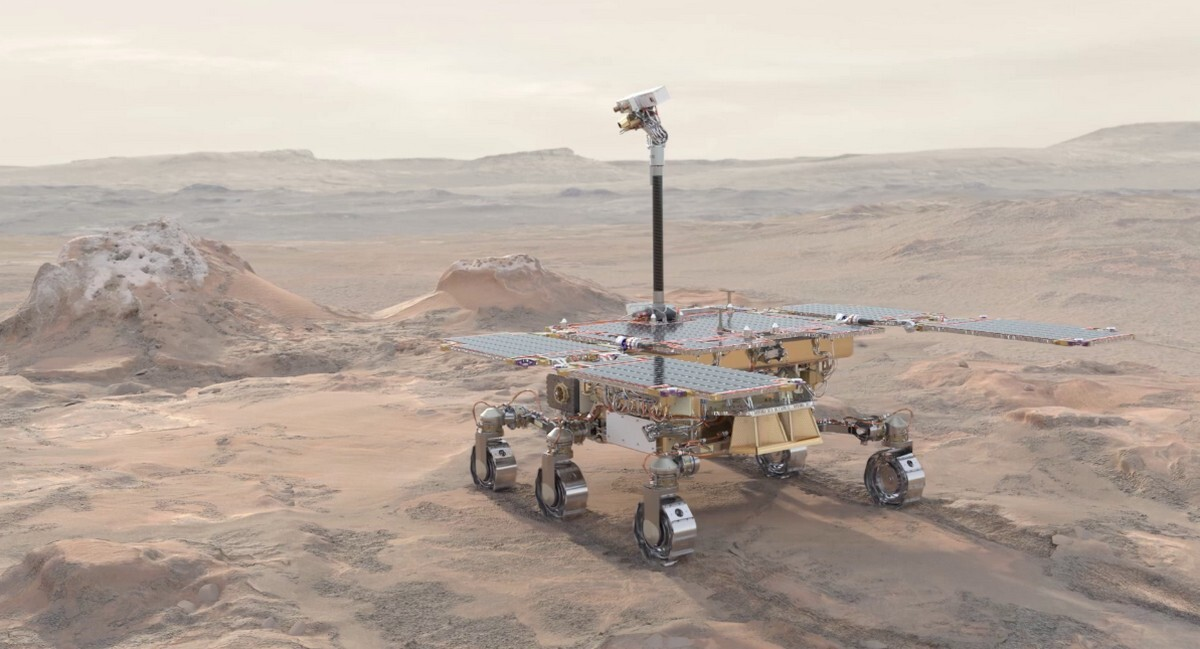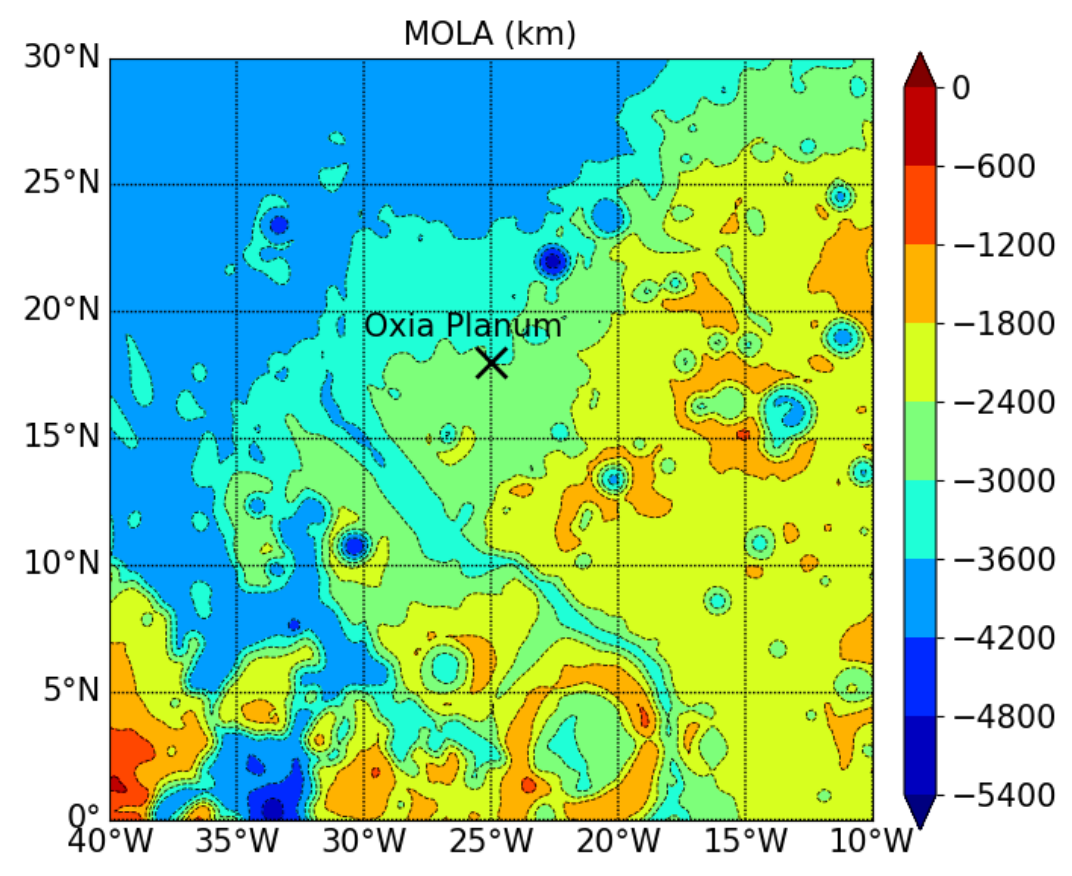Characterization of the Martian atmosphere for ExoMars - Rosalind Franklin Rover Entry-Descent-Landing
- 1Laboratoire de Météorologie Dynamique, Planétologie, Paris, France (charlotte.segonne@lmd.ipsl.fr)
- 2Centre for Mars Meteorology Monitoring, Paneureka, Le Bourget-du-Lac, France
Introduction: The Rosalind Franklin Rover of the European Space Agency (ESA) will be launched in 2028, as the second part of the ExoMars program. The Rosalind Franklin Rover (RFR) (Fig. 1) will explore the surface and subsurface of Mars in Oxia Planum (18.20°N ; 335.45°E). The aim will be to collect samples of well-preserved organic material down to a depth of 2 m. The Entry-Descent-Landing (EDL) phase of RFR is critical and decisive and requires meeting the engineering threshold constraint for parachute deployment and rover deceleration. Thales Alesia Space Italia is in charge of preparing RFR's EDL. Our contribution to this task is to provide some characterization and forecast of the weather conditions and turbulence in Mars’ atmosphere, for the chosen landing period and area. This is a presentation of the methodology, models and observations/data we will be using.

Figure 1: Representation of Rosalind Franklin Rover on Mars’ surface. (Credits: ESA/Mlabspace)
Methodology: Mars' atmosphere is complex in terms of structure and dynamics. It can be affected by strong winds, presence of water ice clouds and high density of dust particles. The thermal structure of Mars’ atmosphere and its atmospheric circulation are controlled by the amount and transport of airborne dust [1].
Our objective is to represent and characterize Mars’ atmosphere with realistic conditions, while taking into account conditions that can be extreme, to encompass all possible wind and dust density scenarios at the time and in the area of the EDL. To be able to do this fully, models spanning different resolved scales will be used: a General Circulation Model (GCM) that is the Mars PCM (Planetary Climate Model) [2] and the Mars Climate Database (MCD) [2, 3] for global scale, the Mars Mesoscale Model (MMM) [4] for regional scale and microscale model, Large Eddy Simulation (LES) [5], for local turbulence.

Figure 2: Mesoscale domain topography centered on the landing site of Oxia Planum marked by cross.
Numerical Simulations: The landing of RFR is scheduled in 2030, prior to the Martian dusty season (Ls > 180°), after a two-year transfer to Mars. However, although unlikely, the occurrence of local or regional dust storms is plausible and must be taken into account in the simulations. Hence four dust scenarios will be used: climatology, cold (clear atmosphere), warm (dusty atmosphere) and a dedicated scenario (local dust storm). The dedicated scenario will be based on an extrapolation of dust column maps of Mars’ multi-annual climatology of dust distribution (from Mars year 24 to 37) [6, 7] to create a realistic extreme scenario.
Using those dust scenarios, Mars’ atmosphere will be simulated with the Mars PCM and MMM to make regional characterization of the extreme horizontal and vertical winds in Oxia Planum. The mesoscale domain is set to an area ranging from −40° E to −10° E in longitude, and from 0° to 30° N in latitude, covered by 180x180 grid points (Fig. 2) with a horizontal resolution of around 10km. Then, to take into account the convection activity induced by solar surface heating, a local characterization of convective updrafts, downdrafts and shears will be made using LES with an even finer resolution of less than 50m.
Observations and data: The Mars Dust Activity Database (MDAD) [8] and data from instruments such as the spectrometer TES, EMIRS, THEMIS, the radiometer MCS can provide observations of Mars’ atmosphere in Oxia Planum from which water ice cloud horizontal distribution, atmospheric density or temperature profiles can be retrieved.
These observations will serve as a reference to evaluate the outputs of simulations at different scales. And thus makes it possible to assess the possible biases in the simulations that should be taken into account.
References: [1] The Atmosphere and Climate of Mars (2017) ISBN-13: 9781107016187. [2] Forget, F. et al. (1999), J. Geophys. Res., 104, E10, 24155-24176. [3] Millour, E. et al. (2024), 10th Mars Conference. [4] Spiga, A., and F. Forget (2009), J. Geophys. Res., 114, E02009. [5] Spiga, A., et al. (2010) Quarterly Journal of the Royal Meteorological Society, 136:414–428. [6] Montabone, L. et al. (2015) Icarus, 251, pp. 65-95. [7] Montabone, L. et al. (2020) J. Geophys. Res. - Planets. [8] Battalio, M. and Wang, H. (2021), Icarus, 354, 114059.
How to cite: Segonne, C., Millour, E., Montabone, L., Forget, F., and Spiga, A.: Characterization of the Martian atmosphere for ExoMars - Rosalind Franklin Rover Entry-Descent-Landing, Europlanet Science Congress 2024, Berlin, Germany, 8–13 Sep 2024, EPSC2024-759, https://doi.org/10.5194/epsc2024-759, 2024.